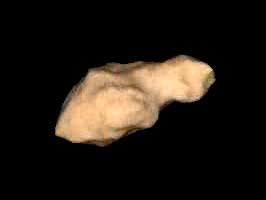An explosive asteroid affected the Earth's climate during the Miocene period
A group of American scientists found the undersea of the explosion of a large asteroid with debris drifting to Earth could make our planet's climate cooler 8.3 million years ago. year.

Asteroid Toutatis (Photo: Astrosurf)
Researchers at the California Institute of Technology (Caltech) have noted that by the end of the Miocene period, in the subsoil layers, the concentration of helium 3 was 4 times higher than normal.
Helium 3 is an isotope of helium, a very common gas in the universe that is often used to pump balls in fairs. Helium 3 is composed of 2 protons and 1 neutron, in normal helium ki (He2) consisting of only 1 proton and 1 neutron.
Helium 3 is rare on Earth, but the cosmic dust particles that fall on the planet have been supplemented by the solar wind He3 during the journey. Therefore, this isotope is a reliable marker of the intensity of the interplanetary precipitation dust falling on Earth.
Research on sediments in the Indian and Atlantic Oceans proves that the concentration of helium 3 has reached its peak in two times 35 million years ago and 8.3 million years. If for the first time due to the effects of celestial bodies, the second time is consistent with the explosion of a large asteroid with a diameter of over 150 kilometers. The largest debris now forms a group of Veritas asteroids about 300 million kilometers from Earth.
Nearly half of the asteroid's mass may have been thrown in the form of dust with some falling on our planet. 5 tons of this dust still falls to Earth every year.
Cold climates are often explained by the presence of atmospheric dust particles - derived from volcanoes, collisions between meteorites, even pollution - darkening the atmosphere and reflection. solar radiation.
- What is Climate Change?
- Climate change changes people's creativity
- Detector for explosive materials under the sea
- Israel develops explosive devices using nanotechnology
- Afghanistan is richer than we think
- Climate change: Vietnam is affected
- The most affected people because the earth warms up
- The asteroid is about to fly closest to Earth in 115 years
- 6 potentially explosive objects right next to us
- The Earth's climate will get cold
- Asteroid 800,000km2 fly near the Earth
- Asia has been affected by climate change from 34 million years ago
 Van Allen's belt and evidence that the Apollo 11 mission to the Moon was myth
Van Allen's belt and evidence that the Apollo 11 mission to the Moon was myth The levels of civilization in the universe (Kardashev scale)
The levels of civilization in the universe (Kardashev scale) Today Mars, the sun and the Earth are aligned
Today Mars, the sun and the Earth are aligned The Amazon owner announced a secret plan to build a space base for thousands of people
The Amazon owner announced a secret plan to build a space base for thousands of people